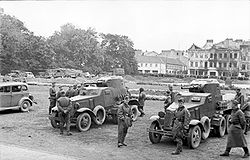BA-10
| BA-10 | |
|---|---|
DT machine guns (2079 rounds). | |
| Engine | GAZ-MM 50 hp (37 kW) |
| Power/weight | 10 hp/tonne |
| Suspension | wheeled |
Operational range | 300 km (190 mi) |
| Maximum speed | 53 km/h (33 mph) |
The BA-10 (
BA-6 heavy armored cars. It had an improved GAZ-AAA chassis and improved armor (up to 15mm at front and turret). It was intended that the BA-10 would be replaced in 1941 by the BA-11 with diesel engine and more sophisticated armor design, but the outbreak of war prevented BA-11 production. The BA-10 was in Red Army service until 1945. Significant numbers of captured BA-10s were used by Finland (at least 24), Germany and other Axis powers
in Europe.
Development
During the late 1930s, Soviet armoured fighting vehicle designers incorporated
sloped armor
into all their new designs, and redesigned some existing vehicles to take advantage of it. The BA-10 used a slightly smaller, better-sloped armor layout than that of the BA-6, thus improving protection while saving weight. The greater engine power (50 hp (37 kW), compared to 40 hp (30 kW) on the BA-6) made the vehicle more reliable.
Like its predecessors, the BA-10 could be converted to a
tracks
to the rear pair of dual tandem wheels. On early BA-10s, these tracks were stowed strapped on top of the fenders. Later vehicles had an enclosed stowage box for the tracks in the same location. The tracks were often fitted when the vehicle needed to move across snow or soft ground.
In action
The BA-10 first saw action against the Japanese in Manchuria at the
.
During
front.Large numbers of captured BA-10s were used by Axis powers in Europe. In May 1945 a few BA-10s of ROA fought alongside the defenders of the Prague uprising.
References
- Notes
- ISSN 1765-0828.
- Bibliography
- М. Коломиец. Броня на колёсах. История советского бронеавтомобиля 1925–1945. — Москва: Яуза, Стратегия КМ, Эксмо, 2007. — 384 с. — (Советские танки). — 6000 экз. — ISBN 978-5-699-21870-7
- А. Г. Солянкин, М. В. Павлов, И. В. Павлов, И. Г. Желтов. Отечественные бронированные машины. XX век. 1905–1941. — Москва: Экспринт, 2002. — Т. 1. — 344 с. — 2000 экз. — ISBN 5-94038-030-1
Wikimedia Commons has media related to BA-10.
